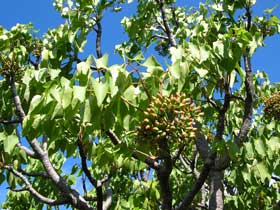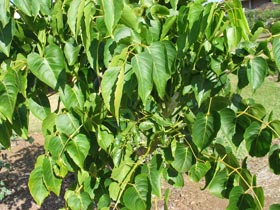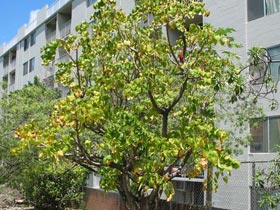Reynoldsia sandwicensis
Genus
Reynoldsia
Species
sandwicensis
Hawaiian Names with Diacritics
- ʻOhe
- ʻOhe kukuluaeʻo
- ʻOhe makai
- ʻOheokai
- ʻOheʻohe
Hawaiian Names
- Ohe
- Ohe kukuluaeo
- Ohe makai
- Oheohe
- Oheokai
Common Names
- Hawaiian reynoldsia
Synonyms
- Reynoldsia degeneri
- Reynoldsia hillebrandii
- Reynoldsia hosakana
- Reynoldsia huehuensis
- Reynoldsia mauiensis
- Reynoldsia oblonga
Distribution Status
Endemic
Endangered Species Status
No Status
Plant Form / Growth Habit
- Tree
Mature Size, Height
- Tree, Small, 15 to 30
- Tree, Medium, 30 to 50
- Tree, Large, Greater than 50
Mature Size, Width
ʻOhe makai can have a nearly 60-foot spread.
Life Span
Long lived (Greater than 5 years)
Landscape Uses
- Provides Shade
- Specimen Plant
- Container
Plant Produces Flowers
Yes
Flower Type
Not Showy
Flower Colors
- Green
- Orange
- Purple
- Yellow
Additional Flower Color Information
Flowers of ʻohe makai are on short racemes, ranging in color from greenish-yellow to orange purple.
Blooming Period
- Fall
Additional Blooming Period Information
Small dark purple fruits follow the blooming period.
Plant texture
- Medium
Additional Plant Texture Information
ʻOhe makai leaves are 2 to 4 inches long.
Leaf Colors
- Light Green
Additional Pest & Disease Information
ʻOhe makai is prone to ants, scale and mealy bugs.
Fertilizer
For young trees an application of a balanced slow release fertilize with minor elements every six months. Foliar feed monthly with kelp or fish emulsion, or a water-soluble fertilizer with a dilution of one half to one third of recommended strength. Large trees will receive nutrients from surrounding soil. Do not fertilize in the summer months.
Pruning Information
Not necessary unless to control canopy spread. Do not cut back too severely though if deciding to prune. ʻOhe makai naturally looses leaves in summer dormancy or at other dry times of the year, so some raking may be necessary then. But the leaves are thin and will compost quickly if left on ground. [David Eickhoff, NPH]
Water Requirements
Dry
Additional Water Information
Too much soil moisture can kill this tree. Once the plant is well established do not water except in extremely dry conditions. Especially do not water in summer dormancy.
ʻOhe makai is a true xeric, or drought tolerant, tree in every sense of the word!
Soil must be well drained
Yes
Light Conditions
- Full sun
- Partial sun
Additional Lighting Information
Full sun to partial sun. But ʻohe makai grows optimally in full sun conditions.
Tolerances
- Drought
- Wind
Soils
- Cinder
Limitations
ʻOhe makai does not like "wet feet," that is, constant moisture in the root area and espeially in the summer.
Natural Zones
- Less than 150, 0 to 50
- Less than 150, 50 to 100
- 150 to 1000, 0 to 50
- 150 to 1000, 50 to 100
- 1000 to 1999, 0 to 50
- 1000 to 1999, 50 to 100
- 2000 to 2999, 0 to 50
- 2000 to 2999, 50 to 100
Natural Range
- Niʻihau
- Oʻahu
- Molokaʻi
- Lānaʻi
- Maui
- Hawaiʻi
Additional Growth Environment Information
ʻOhe makai naturally grows in dry to occasionally mesic forests and is becoming increasingly rare. It is found from about 100 to over 2,600 feet in elevation.
Special Notes and Information
ʻOhe makai belongs to the Ginseng family (Araliaceae), which also includes other native trees such as ʻōlapa (Cheirodendron spp.), munroidendron or pōkalakala, ʻohe mauka (Tetraplasandra spp.), as well as the non-native and invasive octopus tree or heʻe (Schefflera actinophylla).
ʻOhe makai is one of the few native Hawaiian trees that are deciduous, dropping all leaves during the summer month dormancy, or at other dry times of the year.
Early Hawaiian Use:
Boys and girls, as well as men, in old Hawaiʻi nei enjoyed walking on stilts called kukuluaeʻo, or simply aeʻo, named after the long-legged Hawaiian black-necked stilt (Himantopus mexicanus knudsenii). The wood they choose for this game was ʻohe makai. [1]
Landscape Use:
Plant out when trees are young. When established cut back on watering this tree.
Do not be alarmed if you see this tree drop all the leaves in the summer. It is not dead! There is no need to water to encourage leaf growth either. Allow ʻohe makai to rest. Resume watering at end of summer or early fall.
This may not be a choice landscape plant for some gardeners that would not be accustomed to a tropical tree loosing its leaves during the summer dormant period. [Anna Yorba, Hawaiian Garden Design, LLC; David Eickhoff, NPH]
Additional References
[1] "Plants in Hawaiian Culture" by Beatrice H. Krauss, page 89.
Plant Gallery
Back to Plant List
Other Nursery Profiles for Reynoldsia sandwicensis



